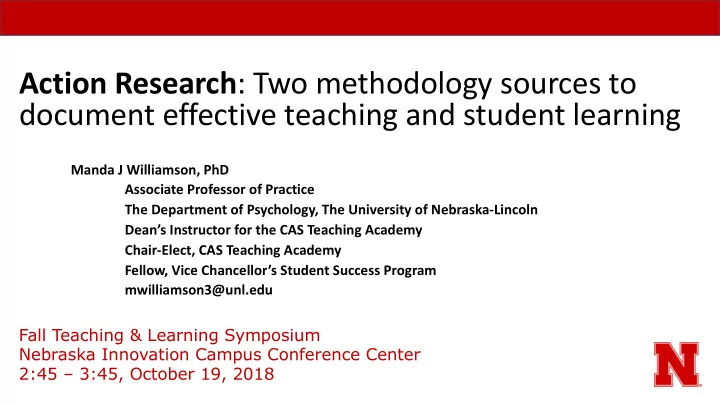

Action Research : Two methodology sources to document effective teaching and student learning Manda J Williamson, PhD Associate Professor of Practice The Department of Psychology, The University of Nebraska-Lincoln Dean’s Instructor for the CAS Teaching Academy Chair-Elect, CAS Teaching Academy Fellow, Vice Chancellor’s Student Success Program mwilliamson3@unl.edu Fall Teaching & Learning Symposium Nebraska Innovation Campus Conference Center 2:45 – 3:45, October 19, 2018
An An Overview: What is “Ac Action Research”? Scholarly Teaching Action Research/ “SoTL” 6. Shared 2. Informs 1. Learning 3. Hypothesis- 5. Peer 4. Design 2. May be 1. Informs 3. Peer with classroom is DV Driven Reviewed; Rigor Shared classroom Reviewed Broader practice Critically within a practice Community; Evaluated restricted Is Public; Is community used by Colleagues
The Process Evaluate, Scrutinize Implement, Develop The Collect Question Data Design See if it’s
Scrutinize: Discover er the the Ques uesti tion • Theory • Observation • Schwab (1973): Someone teaching something to someone else somewhere
Develop a Question : Common Common Qu Question ons Someone Someone Else • “What is going on when?” • “How comfortable are my students with me when________?” • “What is?” “What do my students think about how I • • “What works?” ___________ with them?” • “What is Possible” • “Does this thing assist these learners?” Something Somewhere • “How do I apply this theory of learning?” • “Does this work in this room?” • “How good is this assignment?” • “Within this College?” • “What do my students think about how I • “On this campus?” ___________ with them?” • “In this part of the country?”
Develop a Question: An Annotated Bi Bibliog ography • https://researchsotl.wordpress.com/table-of-contents/
Develop a Question : : Specific Examples • Does collaborative learning improve retention? J • Does using a test bank improve retention? • Does highlighting work better than what ever they are doing when they read text? • Do concept maps foster deeper encoding (enable students to see relationships between concepts)? • Can I restructure a course using recommendations from efficacy theory to build student confidence and foster greater retention?
See if It’s Been Done • Do a lit search • UNL Libraries • Scholar.Google.Com • Summarize the important ones • Add to them
See if It’s Been Done SoTL TL Jo Jour urna nals s tha hat are Disc scipl pline ne-Sp Speci cific • http://www.fctl.ucf.edu/Researc hAndScholarship/SoTL/journals/ • (has acceptance rates listed) • https://belmont.libguides.com/c .php?g=174362&p=1149193 • https://cetl.kennesaw.edu/teach ing-journals-directory
Design Your Procedure • Important guidelines • Measure Twice to Establish Learning • NuGrant Approval • Include Quantitative AND Qualitative Data • PILOT!!!!
Designs: Using ”Think-Pair-Share (Th-P-SH)”
Designs: Using Th-P-SH as the Intervention
Designs: Using Th-P-SH as the Intervention
Designs: Using Th-P-SH as the Intervention
Designs: Establishing Group Equivalency within a Class FMI: NSF User-friendly Handbook for Mixed Method Evaluations https://www.nsf.gov/publications/pub_summ.jsp?ods_key=nsf9 7153 Prior Sections without intervention: control classroom, class time, teacher, materials Obtain class rank and ACT data and demonstrate equivalency
Design Your Procedure: “Assessment” should include two types • “Assess” • Example 1: Objective-to show that “it” worked • Example 2: Subjective (Affective/Motivation) Evaluations of Progress to show why students thought “It” worked • Quantitative and Qualitative Measures
Design: Em Empl ployi ying ng Mi Mixed Me Method od D Designs (q (qualitative and quantitative data) • https://www.nsf.gov/pubs/1997 /nsf97153/start.htm
Do Any Exi Exist? t? Possibl ble e sc scales s to use se when eng engag aged ed in in the the scho holar larship hip of teac eaching hing • http://teachpsych.org/Resources /Documents/ebooks/compscales stl.pdf
An And if you don’t wish to purchase a text.. • Vanderbilt University, “Scholarship of Teaching and Learning” • https://my.vanderbilt.edu/sotl/ • University of Calgary, “A Scholarly Approach to Teaching” • http://sotl.ucalgaryblogs.ca/under standing-sotl/a-scholarly- approach-to-teaching/
Let’s Try Th This… … Please Open Th This Link to Your Go Google le Do Doc: c: • https://docs.google.com/document/d/1yCp3995 MET3dB6HYsRAqo3VufVpR9BoC2T3P- okq9io/edit?usp=sharing
Recommend
More recommend